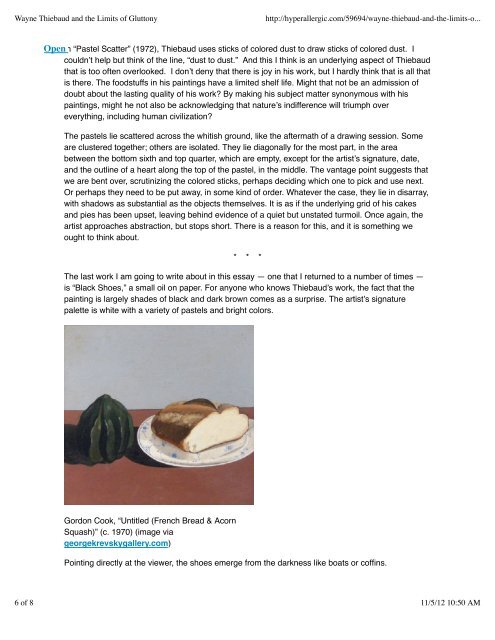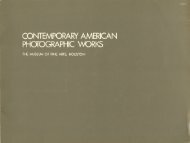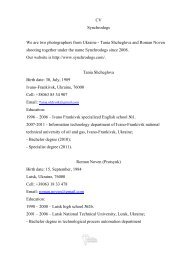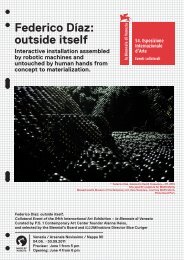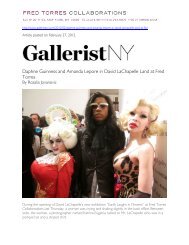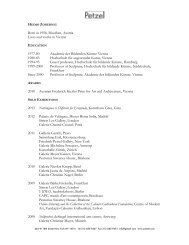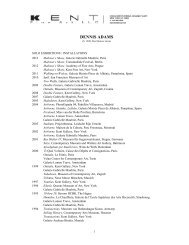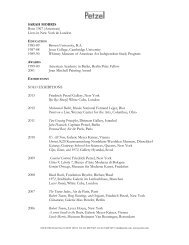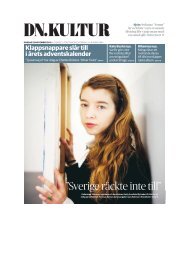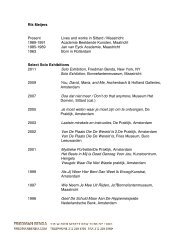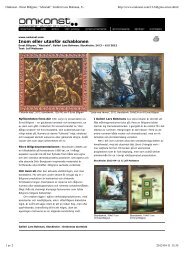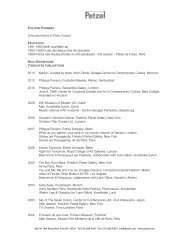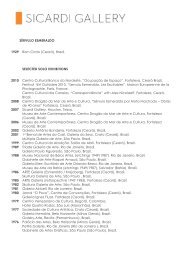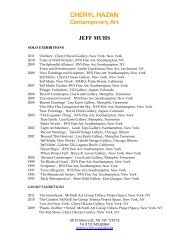Wayne Thiebaud and the Limits of Gluttony - exhibit-E
Wayne Thiebaud and the Limits of Gluttony - exhibit-E
Wayne Thiebaud and the Limits of Gluttony - exhibit-E
You also want an ePaper? Increase the reach of your titles
YUMPU automatically turns print PDFs into web optimized ePapers that Google loves.
<strong>Wayne</strong> <strong>Thiebaud</strong> <strong>and</strong> <strong>the</strong> <strong>Limits</strong> <strong>of</strong> <strong>Gluttony</strong> http://hyperallergic.com/59694/wayne-thiebaud-<strong>and</strong>-<strong>the</strong>-limits-o...<br />
OpenIn<br />
“Pastel Scatter” (1972), <strong>Thiebaud</strong> uses sticks <strong>of</strong> colored dust to draw sticks <strong>of</strong> colored dust. I<br />
couldn’t help but think <strong>of</strong> <strong>the</strong> line, “dust to dust.” And this I think is an underlying aspect <strong>of</strong> <strong>Thiebaud</strong><br />
that is too <strong>of</strong>ten overlooked. I don’t deny that <strong>the</strong>re is joy in his work, but I hardly think that is all that<br />
is <strong>the</strong>re. The foodstuffs in his paintings have a limited shelf life. Might that not be an admission <strong>of</strong><br />
doubt about <strong>the</strong> lasting quality <strong>of</strong> his work? By making his subject matter synonymous with his<br />
paintings, might he not also be acknowledging that nature’s indifference will triumph over<br />
everything, including human civilization?<br />
The pastels lie scattered across <strong>the</strong> whitish ground, like <strong>the</strong> aftermath <strong>of</strong> a drawing session. Some<br />
are clustered toge<strong>the</strong>r; o<strong>the</strong>rs are isolated. They lie diagonally for <strong>the</strong> most part, in <strong>the</strong> area<br />
between <strong>the</strong> bottom sixth <strong>and</strong> top quarter, which are empty, except for <strong>the</strong> artist’s signature, date,<br />
<strong>and</strong> <strong>the</strong> outline <strong>of</strong> a heart along <strong>the</strong> top <strong>of</strong> <strong>the</strong> pastel, in <strong>the</strong> middle. The vantage point suggests that<br />
we are bent over, scrutinizing <strong>the</strong> colored sticks, perhaps deciding which one to pick <strong>and</strong> use next.<br />
Or perhaps <strong>the</strong>y need to be put away, in some kind <strong>of</strong> order. Whatever <strong>the</strong> case, <strong>the</strong>y lie in disarray,<br />
with shadows as substantial as <strong>the</strong> objects <strong>the</strong>mselves. It is as if <strong>the</strong> underlying grid <strong>of</strong> his cakes<br />
<strong>and</strong> pies has been upset, leaving behind evidence <strong>of</strong> a quiet but unstated turmoil. Once again, <strong>the</strong><br />
artist approaches abstraction, but stops short. There is a reason for this, <strong>and</strong> it is something we<br />
ought to think about.<br />
* * *<br />
The last work I am going to write about in this essay — one that I returned to a number <strong>of</strong> times —<br />
is “Black Shoes,” a small oil on paper. For anyone who knows <strong>Thiebaud</strong>’s work, <strong>the</strong> fact that <strong>the</strong><br />
painting is largely shades <strong>of</strong> black <strong>and</strong> dark brown comes as a surprise. The artist’s signature<br />
palette is white with a variety <strong>of</strong> pastels <strong>and</strong> bright colors.<br />
Gordon Cook, “Untitled (French Bread & Acorn<br />
Squash)” (c. 1970) (image via<br />
georgekrevskygallery.com)<br />
Pointing directly at <strong>the</strong> viewer, <strong>the</strong> shoes emerge from <strong>the</strong> darkness like boats or c<strong>of</strong>fins.<br />
6 <strong>of</strong> 8 11/5/12 10:50 AM


